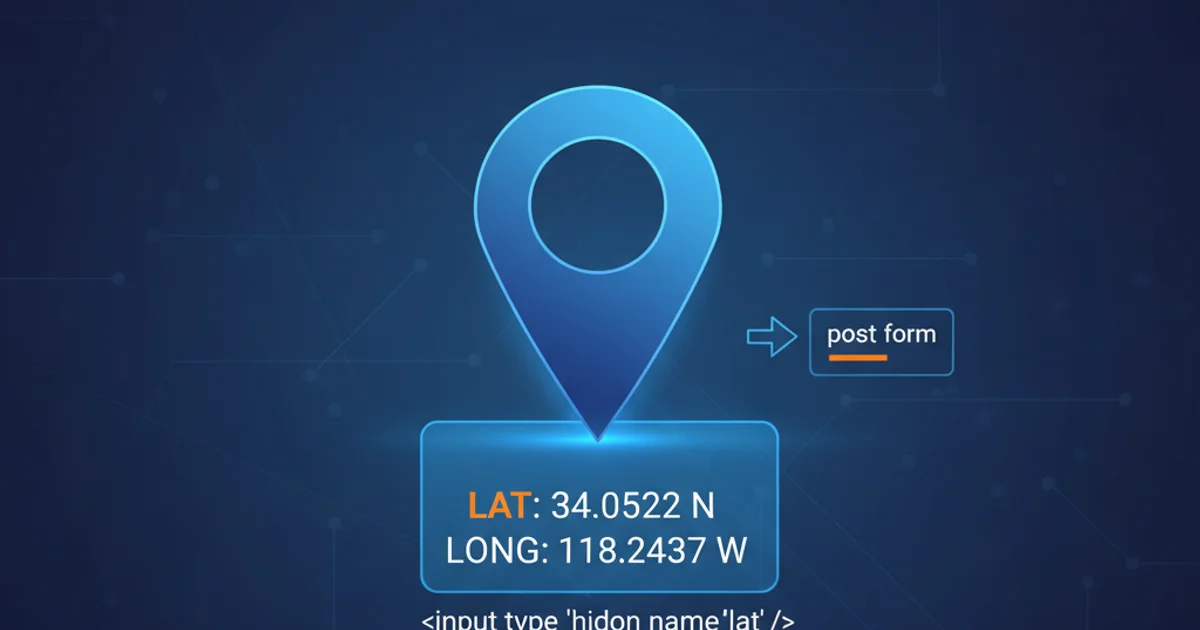Passing geolocation coordinates to hidden fields in a post form
Categories:
Seamlessly Capture Geolocation Data in Web Forms

Learn how to automatically retrieve a user's latitude and longitude and pass it to hidden form fields using JavaScript, enhancing data collection for location-aware applications.
Collecting geolocation data can significantly enhance the functionality of web applications, from local service finders to event registration forms. This article guides you through the process of using the browser's built-in Geolocation API to obtain a user's current latitude and longitude, and then seamlessly inject this data into hidden input fields within an HTML form. This method ensures that location data is submitted along with other form information without requiring direct user interaction.
Understanding the Geolocation API
The Geolocation API is a powerful feature available in most modern web browsers that allows web applications to access the user's location. It's part of the navigator object and primarily uses the getCurrentPosition() method to retrieve location data. This method takes three arguments: a success callback, an error callback, and an optional PositionOptions object.
When getCurrentPosition() is called, the browser typically prompts the user for permission to access their location. If permission is granted, the success callback is executed with a Position object containing the coordinates. If permission is denied or an error occurs (e.g., GPS not available), the error callback is triggered.
flowchart TD
A[User visits page with form] --> B{Geolocation API called};
B --> C{Browser prompts for location permission?};
C -->|Yes| D{User grants permission?};
D -->|Yes| E[Success: Get coordinates];
D -->|No| F[Error: Permission denied];
C -->|No| E;
E --> G[Populate hidden form fields];
F --> H[Handle error/fallback];
G --> I[User submits form];
I --> J[Server receives form data including coordinates];Geolocation Data Capture Workflow
Setting Up Your HTML Form
First, you'll need an HTML form with hidden input fields to store the latitude and longitude. These fields will not be visible to the user but will carry the geolocation data when the form is submitted. It's good practice to give them descriptive id attributes so they can be easily targeted by JavaScript.
<form id="myForm" action="/submit-location" method="post">
<label for="name">Name:</label>
<input type="text" id="name" name="name" required><br><br>
<input type="hidden" id="latitude" name="latitude">
<input type="hidden" id="longitude" name="longitude">
<button type="submit">Submit Location</button>
</form>
Basic HTML form with hidden latitude and longitude fields.
Implementing JavaScript for Geolocation
The core logic involves a JavaScript function that checks for geolocation support, requests the current position, and then populates the hidden fields. This function should ideally be called when the page loads or when the form is about to be submitted.
document.addEventListener('DOMContentLoaded', function() {
const latitudeField = document.getElementById('latitude');
const longitudeField = document.getElementById('longitude');
if (navigator.geolocation) {
navigator.geolocation.getCurrentPosition(
function(position) {
latitudeField.value = position.coords.latitude;
longitudeField.value = position.coords.longitude;
console.log('Geolocation captured:', position.coords.latitude, position.coords.longitude);
},
function(error) {
console.error('Error getting geolocation:', error.message);
// Optionally, handle errors by setting default values or displaying a message
// latitudeField.value = 'N/A';
// longitudeField.value = 'N/A';
},
{ enableHighAccuracy: true, timeout: 5000, maximumAge: 0 }
);
} else {
console.error('Geolocation is not supported by this browser.');
// Optionally, handle lack of support
// latitudeField.value = 'Browser Not Supported';
// longitudeField.value = 'Browser Not Supported';
}
});
JavaScript to get geolocation and populate hidden fields.
getCurrentPosition(). This allows you to gracefully handle scenarios where the user denies permission, the device cannot get a fix, or geolocation is not supported. You might want to provide a fallback mechanism, like allowing manual input or using IP-based location services.Server-Side Processing (Perl Example)
Once the form is submitted, your server-side script will receive the latitude and longitude along with other form data. Here's a simple example using Perl CGI to demonstrate how to access these values.
#!/usr/bin/perl
use strict;
use warnings;
use CGI;
my $q = CGI->new;
print $q->header;
print $q->start_html('Location Data Received');
my $name = $q->param('name');
my $latitude = $q->param('latitude');
my $longitude = $q->param('longitude');
print "<h1>Thank You, $name!</h1>\n";
print "<p>Your submitted location:</p>\n";
print "<ul>\n";
print "<li>Latitude: $latitude</li>\n";
print "<li>Longitude: $longitude</li>\n";
print "</ul>\n";
print $q->end_html;
Perl CGI script to process submitted form data, including geolocation.